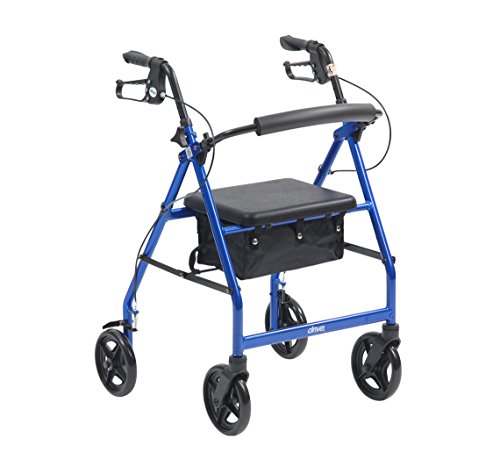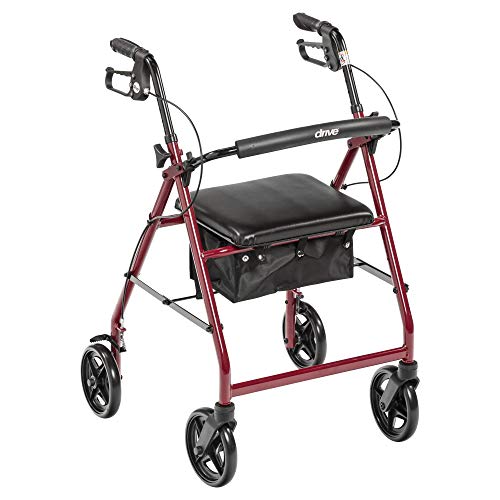What Is Rollator Folding And Why Are We Dissing It?
페이지 정보

본문
 Locking Mechanism For Use With a Foldable lightest rollator
Locking Mechanism For Use With a Foldable lightest rollator Nearly all rollators come with an element of locking or latch to stop them from slamming during storage. This is vital to prevent a potentially hazardous situation during transport.
Nearly all rollators come with an element of locking or latch to stop them from slamming during storage. This is vital to prevent a potentially hazardous situation during transport.The lock is situated in the middle of the frame. It could be a button or lever. It is important to understand how to make use of this feature.
How to fold a Rollator
Rollators are great mobility aids that provide stability and support to those who require it. Rollators are lightweight, practical and are available in a range of models that can be adapted to various budgets and requirements. 1. However, some might be worried about how to fold and unfold a rollator to safely use it.
Fortunately, most modern rollators are built with easy-to-use folding mechanisms. They can be folded quickly without the need for any tools. This makes them ideal for storage and transport. The locking mechanism ensures the walker won't fall open during transport or storage, providing users with security and safety.
Modern collapsible rollator walker walkers aren't only easy to fold, but also feature ergonomic designs that ensure the user's comfort and safety. They come with a large basket, comfortable handles and a brake lever that is designed to prevent accidental activation. They are also made of lightweight rollators materials that allow for mobility and easy handling.
The traditional rollators are heavier and don't have the capacity to support themselves while folded. This makes them difficult to transport or store. Seats are connected to the frame and can't be stored in tight spaces or against objects. Therefore, it is essential for people who have a rollator to learn how to fold their walkers for better storage and transportation.
The first step in folding a rollator with brakes is to find the locking mechanism, which is typically found near the center of the frame of the device. When you locate it and lift it gently, or release it according to the instructions provided by the manufacturer. Once the locking mechanism is removed then you can fold the walker by pushing its sides against each other while holding the releases. Continue to do this until the walker is compact and securely locked.
In addition to making sure that the lock is securely in place In addition, you must inspect your walker for loose components and signs of wear or damage. If you find any problems make sure you repair them as soon as possible to avoid further injury and damage. It is also recommended to regularly lubricate the moving parts of your walker in order to ensure smooth operation and reduce friction.
The Crossbar
The crossbar is the central bar that supports a rollator shopper's frame and wheels. The crossbar is generally made of steel and connects the handlebars to frame's bottom. The crossbar is designed to provide added strength and stability, and it also helps to hold the walker's basket or other accessories. Many manufacturers offer a variety of optional accessories for their walker models, which include storage baskets and tote bags. These can be attached either on the front or back of the walker or placed under the seat.
Many walker models feature a crossbar which can be folded in two directions. This makes them more compact and easier to transport. This is a significant feature, especially in the event that the walker will be often used for travel, or long journeys to the grocery store or other locations. Additionally, certain walker models include a carry bag that can be used for storage space.
Another important characteristic of a rollator is the brakes, which are usually placed on the handles or the crossbar. There are a variety of brake systems, such as cable loop and push-down. The push-down brakes require the user to apply downward pressure to the spring-loaded frame to stop the walker from sliding. This kind of system is not suitable for people with smaller feet who may struggle to engage the breaks or heavier users who may accidentally activate the brakes.
The cable loop brake works more like the brakes of bicycles. It is activated by squeezing the handlebars or levers at the same time using both hands. This type of brake system provides greater control and is for people with weak hand function.
Crossbar could also refer to the vertical stroke that connects two strokes within the letterform. The location, length and width of a crossbar will affect the readability of any letterform. This is a significant difference between serif and non-serif fonts. The crossbar on the smaller e is often called an arm.
The Release Mechanisms
Rollators are a great way to improve mobility and independence for those who are physically challenged. This innovative stability helps distribute the user's weight evenly over their lower body, reducing strain to joints and muscles and allowing for effortless and comfortable movement. These mobility aids are equipped with customizable features such as adjustable handlebars and brakes with built-in seating as well as storage compartments. They allow users to navigate their surroundings in comfort and safety. These lightweight, portable mobility aids can be covered by Medicare and Medicaid to make them more affordable.
Carbon rollators are much easier to store and transport than traditional walkers. They fold in half and can be stored in the trunk. To do this, remove the basket from the frame and then pull up the crossbar. This will reveal pair of release mechanisms on either side. Press the release mechanisms and press the sides of the frame until the walking device shrinks to its smaller size.
The locking assembly is attached to a support arm on top that is substantially horizontal, 218 which joins a pair front and rear tubular legs that are largely vertical. Releasably connected to the ends of the rear and front tubular legs are telescoping tubular leg extensions 226 and 228 respectively. The telescoping extension is able to be rotated from an unlocked to an unlocked position to adjust the height.
Once the leg segments for extension are placed in the right place, a nonsliding handle is fixed to the end of actuating lever. The actuating lever is attached to the housing via an extension piece that extends from the frame, and a recessed portion dimensioned to accommodate the extension piece. The recessed part and the extension piece serve as a fulcrum about which the actuating lever can be pivoted.
When the telescoping legs segments are in the correct position, the locking mechanism activates a snap-button as well as a biasing spring. This arrangement allows the user to engage and disengage the mechanism to fold for easy storage and transport of the walking aid.
The Locking Mechanism
The present invention relates to the locking mechanism that can be used with an walker or rollator that folds. The invention addresses a requirement to have a lock assembly designed for use with these walkers and rollators that is relatively easy to configure between folded and unfolded positions for those who have limited mobility.
Generally, the device comprising two side frames and a cross brace that connects them is comprised of two handles. Two hand brakes are attached to the handles. Each has an actuator that pins with the plunger on the cross bar. When the user presses the hand brakes, the pin-actuating plunger is released, creating a side frame that can rotate into a folded position.
This kind of device has one issue: the actuating handle needs to be held with one hand while trying to push the plunger that is pin-actuated. This could be a challenge for those with limited dexterity or strength of hand. The present invention resolves this issue by incorporating a locking assembly that is operatively linked to the actuating mechanism.
As shown in FIG. as shown in FIG. A lock plate is positioned within the bore and has an opening that is designed to accommodate a locking end of the pin that locks. A part of the actuating lever between the force applying handle end and the body attaching end is configured to pivot relative to both body components so that the locking pin can be moved from a fixed position where it prevents the rotation of the tubular leg to a second position in which the telescoping leg extension can be extended.
When the actuating handle moves, the locking pin moves from the first to the second position. This causes the leg extension that telescoping is able to be removed from the side frame and thereby turns it into its folded position. This can be done with the hand of the user remains in a firm grip on the handgrip 24 on the side frame. This feature can significantly reduce the amount of effort required to fold a Rollator storage bag into and out of its folded position.
- 이전글10 Frauds Buying Used Cars 24.08.25
- 다음글Daycares Popular Listings Fundamentals Explained 24.08.25
댓글목록
등록된 댓글이 없습니다.




